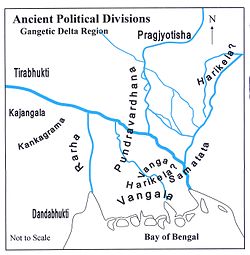Pundravardhana
Pundravardhana | |
|---|---|
| unknown (?~1280 BCE)–unknown (?~300 BCE) | |
 | |
| Capital | Mahasthangarh |
| Common languages | Sanskrit, Pali, Prakrit |
| Religion | Historical Vedic religion Jainism |
| Government | Monarchy |
| Historical era | Iron Age |
• Established | unknown (?~1280 BCE) |
• Disestablished | unknown (?~300 BCE) |
| Today part of | Bangladesh India (West Dinajpur district, West Bengal) |
| History of Bengal |
|---|
 |
Pundravardhana or Pundra Kingdom (
Geography
24°58′N 89°21′E / 24.96°N 89.35°EMahasthangarh, the ancient capital of Pundravardhana is located 11 km (7 mi) north of Bogra on the Bogra-Rangpur highway, with a feeder road (running along the eastern side of the ramparts of the citadel for 1.5 km) leading to Jahajghata and site museum.[4]
Mention in Mahabharata and puranic literature
According to the epic
Ancient period
Birth place of Acharya Bhadrabāhu
The spiritual teacher of Chandragupta Maurya, Jain Ācārya Bhadrabahu was born in Pundravardhana.[7]
Execution of Ajivikas
According to
Discovery
Several personalities contributed to the discovery and identification of the ruins at Mahasthangarh. F. Buchanan Hamilton was the first European to locate and visit Mahasthangarh in 1808, C. J. O’Donnell, E. V. Westmacott, and Baveridge followed. Alexander Cunningham was the first to identify the place as the capital of Pundravardhana. He visited the site in 1889.[10]
References
- ISBN 984-483-245-4
- ^ Ghosh, Suchandra. "Pundravardhana". Banglapedia. Asiatic Society of Bangladesh. Retrieved 10 November 2007.
- ISBN 81-89118-01-3.
- ^ Hossain, Md. Mosharraf, pp. 14–15.
- ISBN 9788120820852.
- ISBN 9788170223740.
- ^ Majumdar, R.C. (1971). History of Ancient Bengal (1971 ed.). Calcutta: G.Bharadwaj & Co. pp. 12, 13.
- ISBN 978-81-208-0616-0. Retrieved 30 October 2012.
- ISBN 978-1-152-74433-2. Retrieved 30 October 2012.
- ^ Hossain, Md. Mosharraf, pp. 16–19
